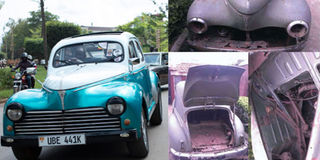Prime
Mubiru’s 1953 Peugeot runs on a Toyota Noah engine

What you need to know:
It had become a source for spare parts and scrap until Mubiru decided to restore his 1995 Peugeot. The lack of an engine forced Mubiru’s mechanic to instead use that of a Toyota Noah, which put his car back on the road.
Until 2012 when he embarked on its restoration, Ivan Mubiru’s Peugeot was all but a shell. It had last been on the road in 1995 when his father last drove it.
During this time, it became a source for those looking for spare parts and scrap, including some components of the engine and the gearbox. At the time, the engine was just a block with many missing parts. It was until 2012 after joining university when Mubiru started the journey to restore the 70-year old car.
The first task he had was looking for a new engine. This took him approximately two years because he wanted one that was similar to or close to the exact engine. After failing to get one in Kampala, Mubiru was advised to try Nairobi, a Kenyan city synonymous with many brands of vintage cars.
After being boxed with high engine costs, his father’s mechanic, who is also a spare parts dealer, advised Mubiru to instead look for different parts of the Peugeot’s initial engine, while another enthusiast gave him the idea to fit the car with an engine from any other car brand in order to start the car.
“After trials, I realised the engine of the Toyota Noah could serve the intended purpose on condition that it was fitted well. Luckily, I got a mechanic who was familiar with the Peugeot since he had been tasked to service it several times when it was still roadworthy. He had also previously helped my father to swap the engine of a Vanguard with that of a 3L Toyota Hiace,” Mubiru says.
“He knew the whole process and started assembling the 3S engine (3S means an engine belongs to the S engine family) of the Toyota Noah in parts and in a shape that could fit into the Peugeot. The engine room of the Peugeot is a V-shape and this means mechanics only fitted the essentials to move the car and had to leave out some parts. It does not have other components such as the complete wiring system or the air conditioner. The 3S engine can work in other types of cars, especially the rear wheel drives, just like the Peugeot,” he adds.
Starting the engine
Now running on a 2000cc 3S Toyota Noah petrol engine, a road test for the French brand running on a Japanese engine had to wait until 2016. However, upon starting, it had many mechanical issues. Mubiru’s mechanic was then faced with a fresh task of modifying the propeller and the double differential, commonly known as the double diff, to match the small car body.
“After modifying the propeller and double diff, I did other modifications such as the orange rear lights above the rear door because the car did not have any at the back. It only came with brake lights at the rear that also came with inbuilt reflectors. I also modified a few round lights similar to those of Land Rover Defenders at the rear for visibility when driving at night,” Mubiru explains.
Usability
Unlike your daily drive car, Mubiru drives his restored Peugeot at the weekend. Its consumption is similar to that of the Toyota Premio. The longest he has driven it to is Entebbe from Kampala. Its service is done once in four months, depending on what needs to be done.
Since he carried out an engine swap, what the engine counts is not what shows on the speedometre. This makes reading its correct mileage impossible, just like reading the driving speed whose speedometre is not connected yet. It is still a work in progress, with Mubiru arguing that it is far from the mechanical condition he wants it to be.
Spare parts
According to Mubiru, the fact that the Peugeot runs on a Toyota engine means the spare parts are readily available. However, he consults his mechanic who carried out the engine swap first before buying any part. The engine and its corresponding gearbox cost Mubiru Shs2.7m, including labour, which have been the highest restoration cost.
The Peugeot’s gears were initially manual but were converted to automatic during restoration, with most of the parts needed during the process being sourced outside Uganda. It is a five seater, whose maximum speed is supposed to be 180km/hr as per the Toyota engine, but the initial speedometer reads 90km/hr.
Before an engine swap
Before carrying out an engine swap, it is better to understand whether your car is rear or front wheel drive. Then, consider the engine room because some engines are fixed in cars cross- sectionally and others longitudinally, while others are fitted in V-shape. The suspension and engine mounting also matter because these will be adjusted to fit the engine, besides determining the car’s driving comfort. Parts of the drive trail such as the propeller should not be forgotten.
Mubiru’s Peugeot does not only come with a manually closed and opened sunroof but it also runs on 15-inch rim size and 205 tyres sizes.




